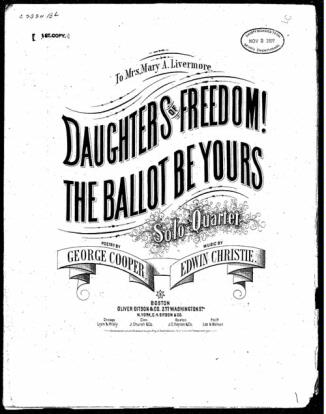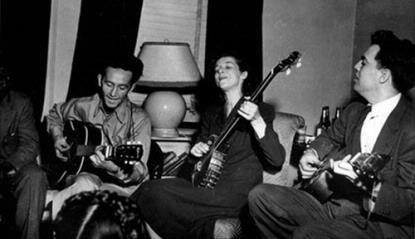
Editor’s Note: The Worcester Art Museum has a current exhibit of photographs, From Kennedy to Kent State, with accompanying programming supported by a grant from Mass Humanities. On December 20 at 6 pm, Dr. Robert J.S. Ross will present a talk on “Songs of the Protest Movement,” the movement in question being the Civil Rights Movement. I asked music scholar Daniel Carroll to provide a brief essay on protest music (with links to samples) in the US starting with the nineteenth century suffrage movement. Dr. Ross will be posting about the music of the Civil Rights Movement next week.
* * * *
Music has long been associated with periods of formidable social, political, and economic unrest throughout the world. The simplicity of much protest music, along with its ease of internalization and dissemination, has facilitated a needed outlet for the oppressed of various stamps. The music seemed to serve a dual purpose of catharsis and organization, at once permitting the expression of anger and dissatisfaction as well as promoting solidarity among one’s fellows.
At least the musical products of oppression stand as enlightening contributions to our rich musical heritage.
Consider, first, the suffrage-era song “Give the Ballot to the Mothers,” with words by Rebecca N. Horaid and set to the music of the Civil War song “Marching through Georgia.”
Bring the dear old banner, boys
And fling it to the wind;
Mother, wife, and daughter
Let it shelter and defend;
Equal rights our motto is,
We’re loyal to the end—
Giving the ballot to the mothers.[1]
Suffrage sheet music was published by prominent music publishing companies, such as “Daughters of Freedom, the Ballot be Yours!” (1871, composed by Edwin Christie with lyrics by George Cooper), published by Oliver Ditson & Co., one of the oldest and largest music publishers in the US. Such music was written for four vocal parts and piano accompaniment (to hear a version of “Daughters of Freedom,” follow the link).
The labor movement of America in the late nineteenth century (the legality of labor unions was established by the landmark case “Commonwealth vs. Hunt” in 1842) had its own traditions of poetry and songs. Michael McGovern, an Irish immigrant steel and iron worker, wrote the following in his work “The Puddler’s View of Present Systems.”
The plutocrats, the gold bugs, and the tariff lords that rule us all,
The press and politicians that would tell us lies to fool us all,
The ministers and bishops who preach on Christ and pray for all,
The warriors who’d kill the foes that would invade and slay us all,
The hobos and the millionaires who never work at all, at all,
Would one and all be starving did the working man not toil for all![2]

Better known songs of protest employing the voices and perspectives of workers were written by the likes of Woody Guthrie and Pete Seeger; both folk icons began recording around the same time, 1940, and both were associated with Alan Lomax’s Archive of American Folk Songs; Seeger as an assistant to Lomax (who also helped him with his own recording career a bit later), and Guthrie as an artist who was recorded by Lomax for the Archive, housed in the Library of Congress.
The Civil Rights Movement of the 1960s gave us the most well-known popular protest music. These songs were participatory, call and response expression, such as “Lord, Hold my Hand While I Run this Race” (scroll down to listen to a sample). “We Shall Overcome” is an extremely well known (and still sung) example from this era, which points to the nineteenth century spiritual origins of this genre of American Roots music. Writing in the liner notes of a collection of these songs, Bernice Johnson Reagon stated the attention-grabbing potential of this music, even in those of whom protest singers would be ordinarily apprehensive.
In Dawson, Georgia…where Blacks were seventy-five percent of the population, I sat in church and felt the chill that went through a small gathering of Blacks when the sheriff and his deputies walked in. They stood at the door, making sure everyone knew they were there. Then a song began. And the song made sure that the sheriff and his deputies knew we were there. We became visible; our image was enlarged as the sounds of the freedom songs filled all the space in that church.[3]
The theme that unites these styles and genres is, of course, a desire for justice. Naturally, many of those who were striving for their own justice would not live to see it rendered. But, if the goal of such songs is the deliverance of justice by the mechanisms of our so-called “civilized and humane jurisprudence,”[4] then perhaps the memory of those who perished before they received their just restitution can be satisfied that various legislative actions, spurred on in no small measure by their words and songs, have provided some level of justice to their posterity. “Laden with precious freight now thunders on the progress car!”[5]
Images:
Cover sheet for “Daughters of Freedom,” 1871, Boston, Oliver Ditson & Co.
Sonny Terry (obscured), Woody Guthrie, Lilly Mae Ledford, Alan Lomax, New York, 1944. Photographer unknown. Source: American Folklife Center
[1] Irwin Silber, liner notes, “A Brief History of the Women’s Suffrage Movement,” in Songs of the Suffragettes, sung by Elizabeth Knight, accompanied on guitar by Sol Julty (Folkways Records and Service Corporation, FH 5281, 1958), p 7 of liner notes.
[2] Recited by Bucky Halker on American Labor Song-Poems and Labor Protests, 1865-95. Cassette Tape, ISBN 0-252-02056-1, 1992.
[3] Emphasis added. Liner Notes of Voices of the Civil Rights Movement: Black American Freedom Songs, 1960-1966, p. 2.
[4] A quotation from the first inaugural address of President Abraham Lincoln. The Literary Works of Abraham Lincoln, edited by David D. Anderson (Columbus Ohio: Charles E. Merrell Publishing Company, 1970), 210.
[5] A line from a different popular suffrage-era song, “The Suffrage Flag,” with words by William P. Adkinson and sung to the music of the Civil War song “The Bonnie Blue Flag.” Liner notes, Songs of the Suffragettes, p. 7.


